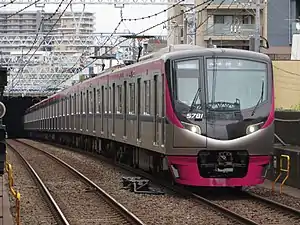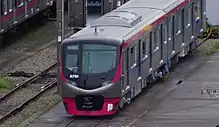Keio 5000 series (2017)
The Keio 5000 series (京王電鉄5000系) is an electric multiple unit (EMU) commuter train type operated by the private railway operator Keio Corporation in the Tokyo area of Japan since 29 September 2017. A total of six ten-car trainsets were built by J-TREC. The trains feature rotating seats that can be arranged longitudinally for daytime services and in forward-facing transverse pairs for reserved-seat Keio Liner commuter services in the evenings which started on 22 February 2018.
| Keio 5000 series | |
|---|---|
 Set 5781 in service in June 2019 | |
| Manufacturer | J-TREC |
| Built at | Yokohama |
| Family name | Sustina |
| Constructed | 2017-2019 |
| Entered service | 29 September 2017 |
| Number built | 60 vehicles (6 sets) |
| Number in service | 60 vehicles (6 sets) |
| Formation | 10 cars per trainset |
| Fleet numbers | 5731-5736 |
| Operator(s) | Keio Corporation |
| Line(s) served | |
| Specifications | |
| Car body construction | Stainless steel |
| Car length |
|
| Width | 2,800 mm (9 ft 2 in) |
| Height | 4,090 mm (13 ft 5 in) |
| Doors | 4 pairs per side |
| Maximum speed | 130 km/h (80 mph) (maximum design speed) |
| Traction system | Hitachi-made VVVF (Silicon carbide hybrid device Si-IGBT SiC-SBD)[1] |
| Traction motors | Induction motor |
| Power output | 150 kW x 4 per motored car |
| Acceleration | 3.3 km/h/s |
| Deceleration | 4.0 km/h/s (service) 4.5 km/h/s (emergency) |
| Electric system(s) | 1,500 V DC overhead catenary |
| Current collection method | Single-arm pantograph |
| Bogies | TS-1017C (motored) TS-1018CD (trailer)[1] |
| Braking system(s) | Regenerative braking with electronically controlled pneumatic brakes[1] |
| Track gauge | 1,372 mm (4 ft 6 in) Scotch Gauge |
Design
The fleet of five ten-car 5000 series trainsets was built by Japan Transport Engineering Company ("J-TREC") at a total cost of approximately JPY10 billion.[4] A sixth set was delivered in December 2019.[5]
 A 5000 series TS-1018CD trailer bogie
A 5000 series TS-1018CD trailer bogie
Formation
The ten-car trains are formed as follows, with six motored ("M") cars and four non-powered trailer ("T") cars, and car 10 at the Shinjuku (eastern) end.[1]
| Car No. | 1 | 2 | 3 | 4 | 5 | 6 | 7 | 8 | 9 | 10 |
|---|---|---|---|---|---|---|---|---|---|---|
| Numbering | Tc2 | M2 | M1 | T2 | M2' | M1' | T1 | M2 | M1 | Tc1 |
| Numbering | 578x | 528x | 523x | 558x | 518x | 513x | 553x | 508x | 503x | 573x |
| Weight (t) | 29.8 | 35.6 | 36.3 | 26.7 | 34.0 | 35.4 | 26.8 | 35.8 | 36.3 | 30.2 |
| Capacity (total/seated) longitudinal config. |
119/39 | 130/45 | 130/45 | 130/45 | 130/45 | 130/45 | 130/45 | 130/45 | 130/45 | 119/39 |
| Capacity (total/seated) transverse config. |
115/39 | 126/45 | 126/45 | 126/45 | 126/45 | 126/45 | 126/45 | 126/45 | 126/45 | 115/39 |
Cars 2, 3, 6, 8, and 9 each have one single-arm pantograph.[1]
Interior
Passenger accommodation consists of rotating pairs of seats that can be arranged in longitudinal configuration for regular daytime services or in transverse forward-facing configuration for reserved-seat evening commuter services from Shinjuku in Tokyo to Keio Hachioji and Hashimoto.[4] LED lighting is used in the interiors, and pairs of LCD passenger information screens are provided both above the doorways and suspended from the ceilings. Free WiFi and AC power sockets are provided. Space for wheelchairs and pushchairs are provided in each car.
 The interior with seats arranged in longitudinal configuration
The interior with seats arranged in longitudinal configuration The interior with seats arranged in transverse configuration
The interior with seats arranged in transverse configuration Three-person seating at a car end
Three-person seating at a car end LCD passenger information screens
LCD passenger information screens
History
Details of the new trains were officially announced in March 2016. Between April and May 2017, Keio held a public poll to choose the brand name for the new reserved-seat services starting in spring 2018. The name Keio Liner was announced on 24 January 2018, chosen from the following five candidates.[6]
- Keio Liner (京王ライナー)
- Keio Smart Liner (京王スマートライナー)
- Keio Prime Liner (京王プライムライナー)
- Luxpress
- Westar
The first trainset was delivered to Wakabadai Depot from the J-TREC factory in Yokohama in late June 2017,[7] and unveiled to the media on 19 July 2017.[8] It entered revenue service on 29 September 2017.[9] The fifth set was in service by January 2018.[10]
Reserved-seat Keio Liner services from Shinjuku Station commenced on 22 February 2018.[11] Inbound Keio Liner trains to Shinjuku will begin on 22 February 2019.[12]
The order of a sixth set was announced in April 2019. The set was delivered in December 2019.[5]
Build histories

The manufacturers and delivery dates for the fleet are as shown below.[14]
| Set No. | Manufacturer | Date delivered |
|---|---|---|
| 5731 | J-TREC | 30 June 2017 |
| 5732 | J-TREC | 15 September 2017 |
| 5733 | J-TREC | 2017 |
| 5734 | J-TREC | |
| 5735 | J-TREC | |
| 5736 | J-TREC | December 2019[5] |
See also
- Seibu 40000 series, a Seibu Railway commuter EMU type that also features rotating longitudinal/transverse seating
- Tobu 50090 series and 70090 series, Tobu Railway commuter EMU types that also features rotating longitudinal/transverse seating
- Keikyu 2100 series, a Keikyu commuter EMU type that also features transverse seating
- Kintetsu 5820 series, a similar type with changing seat configurations operating for Kintetsu Railway, the curators of the design
References
- 京王電鉄5000系 [Keio Corporation 5000 series]. Japan Railfan Magazine (in Japanese). Vol. 57 no. 679. Japan: Koyusha Co., Ltd. November 2017. p. 52-57.
- 京王電鉄の新型「5000系」、新宿~八王子・橋本で座席指定列車運行 [New Keio 5000 series trains to operate on reserved-seat services between Shinjuku and Hachioji/Hashimoto]. SankeiBiz (in Japanese). Japan: Sankei Digital Inc. 16 March 2016. Archived from the original on 19 May 2016. Retrieved 28 February 2017.
- "【京王】5000系5736編成の話題" [(Keio) 5000 series set 5736 topic]. rail.hobidas.com (in Japanese). Neko Publishing. 24 December 2019. Archived from the original on 14 January 2020. Retrieved 14 January 2020.
- 京王線の座席指定列車、愛称は「京王ライナー」 [Brand name "Keio Liner" chosen for Keio Line reserved-seat train]. Sankei News (in Japanese). Japan: The Sankei Shimbun & Sankei Digital. 24 January 2018. Archived from the original on 25 January 2018. Retrieved 26 February 2018.
- 【京王】新5000系 若葉台検車区へ搬入 [Keio new 5000 series delivered to Wakabadai Depot]. Tetsudo Hobidas (in Japanese). Japan: Neko Publishing Co., Ltd. 30 June 2017. Archived from the original on 30 June 2017. Retrieved 30 June 2017.
- 京王5000系が公開される [Keio 5000 series shown off]. Japan Railfan Magazine Online (in Japanese). Japan: Koyusha Co., Ltd. 19 July 2017. Archived from the original on 19 July 2017. Retrieved 19 July 2017.
- 京王5000系営業運転開始 [Keio 5000 series enters revenue service]. Tetsudo Hobidas (in Japanese). Japan: Neko Publishing Co., Ltd. 29 September 2017. Archived from the original on 29 September 2017. Retrieved 29 September 2017.
- 京王5000系第5編成が営業運転を開始 [Keio 5000 series 5th set enters revenue service]. Japan Railfan Magazine Online (in Japanese). Japan: Koyusha Co., Ltd. 7 January 2018. Archived from the original on 8 January 2018. Retrieved 9 January 2018.
- “京王ライナー”の運転開始 ["Keio Liner" services start]. Japan Railfan Magazine Online (in Japanese). Japan: Koyusha Co., Ltd. 23 February 2018. Archived from the original on 26 February 2018. Retrieved 26 February 2018.
- "京王線・井の頭線のダイヤ改正を実施します" (PDF) (Press release) (in Japanese). Keio Corporation. 22 January 2019. Retrieved 19 February 2019.
- 私鉄車両のうごき [Private railway rolling stock changes]. Tetsudo Daiya Joho Magazine (in Japanese). Vol. 47 no. 405. Japan: Kotsu Shimbun. January 2018. p. 104.
External links
| Wikimedia Commons has media related to Keio 5000 series (II). |
- Official news release (in Japanese)